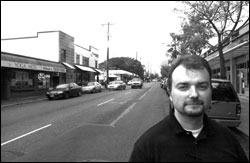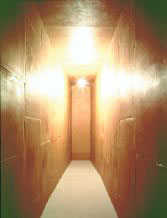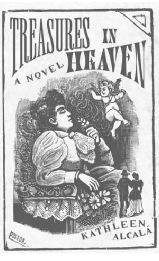IF CAPITOL HILL, like aboriginal Australia, were marked with invisible songlines, then Broadway would belt out a show tune, the Pike/Pine corridor a techno concoction, and 15th Avenue an indie-rock anthem. Until you get to 15th Avenue and East John Street. There begins a different song. Something like Tom Waits with Madonna as backup, or Yo-Yo Ma trading licks with John Lee Hooker. Bisecting 15th, like the No. 43 bus snaking left then right on its way to the University District, the new song marks my territory: the south side. The other 15th, south of John. Across the tracks. It’s a funky little number, but Safeway’s on one side, Madison Market’s on the other, and Seattle Mental Health’s in the middle. So play it, baby.
In my neighborhood, old queers go to Thumpers and young ones to Lambert House. Yoga on 15th empties you of toxins, and Insomniax Coffee jacks you back up again. With the Teapot and Vegete vegetarian restaurants next to Kidd Valley, even the most schizophrenic eater can be satisfied. I have two choices for day care, two 7-Elevens for smokes, and two teriyaki joints within a stone’s throw.
IT WASN’T UNTIL my 85-year-old neighbor, Amos Waldron, died a few weeks ago that I understood the concept of songlines: paths across the landscape where we sing our stories to each other. With his trademark fedora and Jimmy Durante schnozz, Amos perambulated south of John like a postmanevery day, whatever the weather, and always with some news (usually about the weather). At his memorial service, people he’d sung to for years met each other for the first time, realizing that the odd jumble of small businesses, apartments, retirement homes, halfway houses, and hospitals in our gritty corner of the world really is a neighborhood. And if the neighbors own 750-foot cooperative apartments instead of $700,000 mansions, or stroll the streets crying, shouting, cursing, or confused, that just makes it more interesting.
Clients of Hilltop Manor, a scruffy 16th Avenue home for people with mental-health issues, and clients of the Gaslight Inn, a stunning 15th Avenue bed and breakfast built in 1906, both choose to be here. Perhaps because, as Hilltop administrator Mary Johnson says, “You can pretty much be yourself.” Steve Bennett, the Gaslight’s owner, has lived there since 1973. When he bought the building, it was a 15-room boarding house full of whacked-out people next door to a Christian flophouse. He describes the hood as a “cleaned-up Haight Ashbury” and says he wouldn’t live anywhere else.
Jay Day, owner of the eight-seat, triangular-shaped, basement-situated Ruby Cafe, on the corner of East Pine Street and 15th (you might recognize the house from the film The Fabulous Baker Boys), describes her business as a “little neighborhood morning coffee shop.” She loves the eclecticism of the south side, the Jewish Family Center, the Polish House, the A.M.E. and Greek Orthodox churches within blocks of each other. She also loves the support it gives to small businesses that don’t fit the bill: “People have these wacky dreams, and they’re trying to implement them.” (Having started the Globe Cafe, one of the longest-running vegan restaurants in Seattle, just a few blocks away, she knows how important dreams are to a community.)
Bonney Jean Edwards’ dream was to start her own salon. As a kid growing up on north Capitol Hill, she used to visit the sample boutique that stood where she now rents a ground-floor retail space in the Group Health building. “I knew the neighborhood from patronizing small businesses,” Edwards says. Having outlasted by 10 years most of the other establishments in the building, she notes that it’s tough. “Most people just don’t know about the other 15th.” Is it the odd personalities, the absence of a label, or the pull of the more established part of 15th, north of John Street, that turns people back at the invisible line?
WHILE A NEW Safeway on 23rd Avenue, a Trader Joe’s on East Madison Street, and a monster condo/retail project on Pine might bring increased foot traffic and recognition to the south side, it’s the same old Seattle song. Can people like Amos continue to sing their stories, or will their voices be drowned by the dull drone of progress? How many stories can we tell at one time? We can’t solo, but can we harmonize?
Michal Wagner’s story took him from prerevolution Poland to Evergreen High School to a $100,000-a-year job in finance. He quit to start a coffee shop. Says customer Helen Miller: “The Insomniax cafe on 15th makes coffee so good, I’ve started drinking mochas there regularly. It’s totally uncool and will never have the hipster customer base of Victrola or Vivace . . . the place can’t decide on a slick imageits atmosphere is a wreckand it doesn’t look like it cares. I love going in there because it doesn’t remind me of anythingit’s its own thing.” You won’t hear that on the radio.








